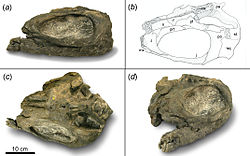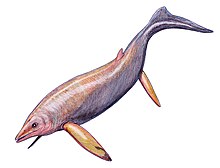Shastasaurus
| Shastasaurus | |
|---|---|

| |
| Partial skull of Shastasaurus pacificus (UCMP 9017) | |
| Scientific classification | |
| Domain: | Eukaryota |
| Kingdom: | Animalia |
| Phylum: | Chordata |
| Class: | Reptilia |
| Order: | †Ichthyosauria |
| Suborder: | † Longipinnati
|
| Node: | †Merriamosauria |
| Family: | †Shastasauridae Merriam, 1895 |
| Genus: | †Shastasaurus Merriam, 1895 |
| Type species | |
| †Shastasaurus pacificus Merriam, 1895
| |
| Species | |
|
†S. pacificus | |
| Synonyms | |
| |
Shastasaurus ("
Description

Shastasaurus lived during the late
Shastasaurus was highly specialized, and differed considerably from other ichthyosaurs. It was very slender in profile. S. sikanniensis had a ribcage slightly less than 2 metres (6.6 ft) deep despite a distance of over 7 metres (23 ft) between its flippers.
It is unknown whether Shastasaurus had a dorsal fin; however, the smaller, more basal ichthyosaur Mixosaurus had one.[11] The upper fluke of the tail was probably much less-developed than the shark-like tails found in later species.[12]
Species and synonyms

The type species of Shastasaurus is S. pacificus, from the late Carnian of northern California. It is known only from fragmentary remains, which have led to the assumption that it was a 'normal' ichthyosaur in terms of proportions, especially skull proportions. Several species of long-snouted ichthyosaur were referred to Shastasaurus based on this misinterpretation, but are now placed in other genera (including Callawayia and Guizhouichthyosaurus).[7]
Shastasaurus may include a second species, Shastasaurus liangae. It is known from several good specimens, and was originally placed in the separate genus Guanlingsaurus. Complete skulls show that it had an unusual short and toothless snout. S. pacificus probably also had a short snout, although its skull is incompletely known.[7] However, a new juvenile specimen discovered in 2013 shows that the hyoid bone of Guanlingsaurus is much shorter, and considered it as a distinct genus based on phylogenetic analysis.[13]
S. sikanniensis was originally described in 2004 as a large species of
In 2009, Shang & Li reclassified the species Guizhouichthyosaurus tangae as Shastasaurus tangae. However, later analysis showed that Guizhouichthyosaurus was in fact closer to more advanced ichthyosaurs, and so cannot be considered a species of Shastasaurus.[7]
Synonyms of S. / G. liangae:
Guanlingichthyosaurus
Synonyms of S. pacificus:
Shastasaurus alexandrae Merriam, 1902
Shastasaurus osmonti Merriam, 1902
See also
- List of ichthyosaurs
- Timeline of ichthyosaur research
- Shonisaurus
References
- ^ "†Shastasaurus Merriam 1895 (ichthyosaur)". Paleobiology Database. Fossilworks. Retrieved 17 December 2021.
- ISBN 0-520-23315-8, at pages 90-91.
- ^ a b Shang Qing-Hua, Li Chun (2009). "On the occurrence of the ichthyosaur Shastasaurus in the Guanling Biota (Late Triassic), Guizhou, China" (PDF). Vertebrata PalAsiatica. 47 (3): 178–193.
- ^ Michael W. Maisch and Andreas T. Matzke (2000). "The Ichthyosauria" (PDF). Stuttgarter Beiträge zur Naturkunde: Serie B. 298: 1–159. Archived from the original (PDF) on 2011-07-18.
- ^ .
- S2CID 245444783.
- ^ PMID 21625429.
- PMID 24348983.
- S2CID 254874088.
- S2CID 129908740.
- ISSN 0567-7920.
- ^ Wallace, D.R. (2008). Neptune's Ark: From Ichthyosaurs to Orcas. University of California Press, 282pp.
- ^ S2CID 83784699.
- ^ Moon, B. (2019). "A new phylogeny of ichthyosaurs (Reptilia: Diapsida)". Journal of Systematic Palaeontology. 17: 1–27.
- hdl:11573/1682932.
- .
- .
